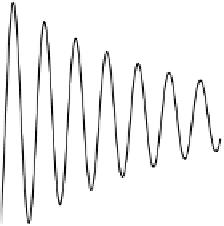Environmental Engineering Reference
In-Depth Information
6.4.1.2
Upper Limit for the Acquisition Time Window and Interferences
from Spurious Reflections
As discussed in the previous section, a longer time window provides both a better
frequency resolution and a more complete spectral representation of the response of
the device under test.
Nevertheless, considering Fig. 6.5, a longer time window does not necessarily
guarantee better results, as can be seen, for example, observing the
S
11
(
)
curve
corresponding to the 100 ns-long time window. In fact, when time window is in-
creased, noise contribution becomes more relevant; this is the intrinsic measurement
limitation for the used instrument.
To verify that the corruption of the measured waveform occurring at longer times
(Fig. 6.3(c)) is mostly due to noise contributions, the TDR response of the AUT
was simulated through a full-wave simulation software, CST Microwave Studio.
The simulation results are reported in Fig. 6.6 for the longer times, and they show a
good agreement with the measurement data. As expected, the only difference is the
noise absence, since the ideal condition is reproduced.
f
0.505
0.500
0.495
40
50
60
70
80
ti me ( ns)
Fig. 6.6
Simulated TDR waveform of the RFId antenna
As mentioned in the previous subsections, another critical issue related to the
upper limit for the acquisition window is related to the possible presence of objects
in the nearby of the AUT.
To verify the influence of the spurious reflection, a second set of measurement
was performed outdoor. Another set of
S
11
(
measurements was performed using a
fixed time window and placing a reflecting object (a steel plate) at a varying distance
from the AUT: this allowed making considerations on the interferences occurring,
for example, when measurements are performed inside a laboratory.
f
)








































Search WWH ::

Custom Search